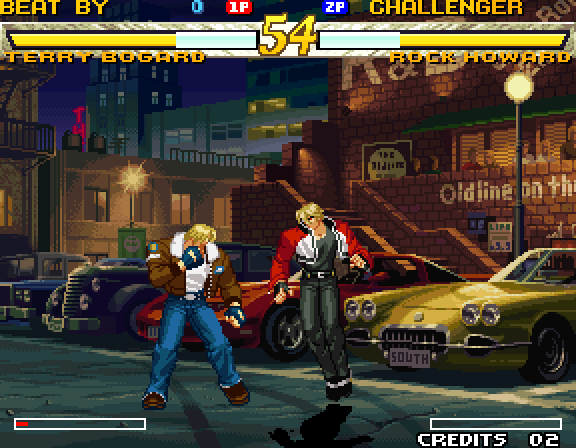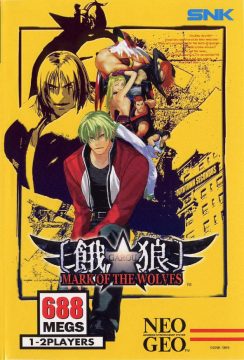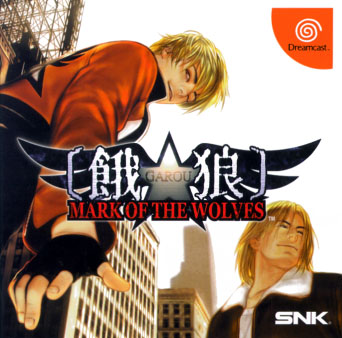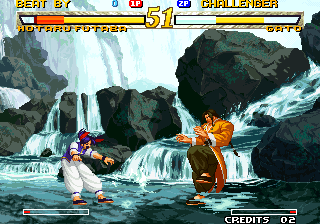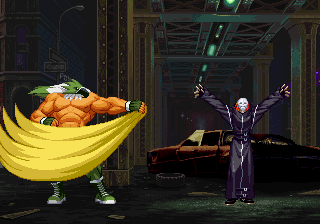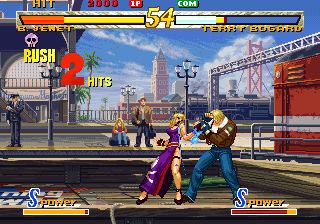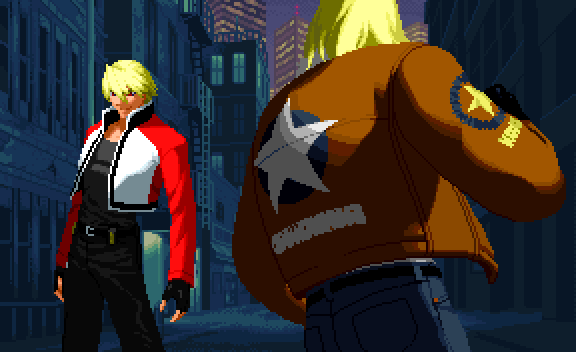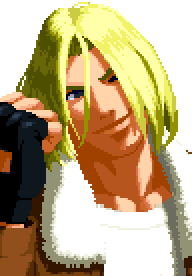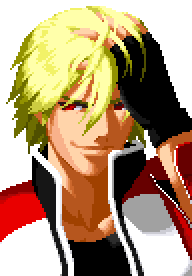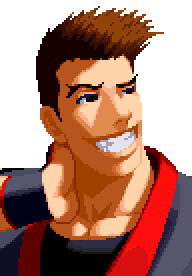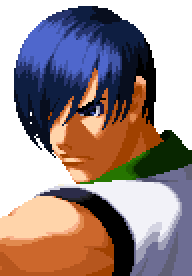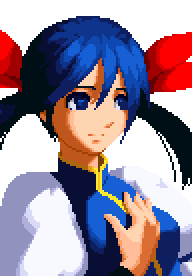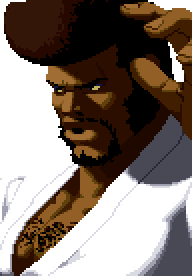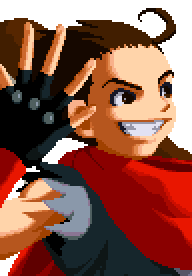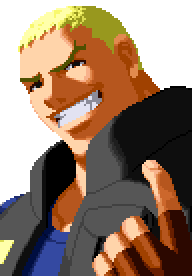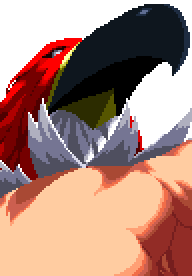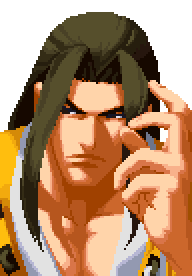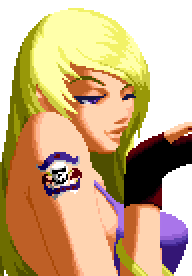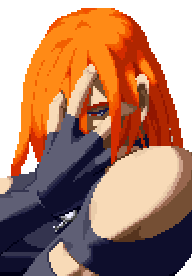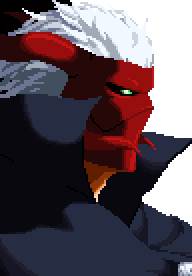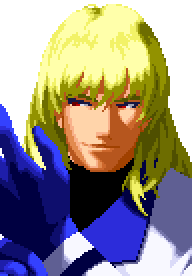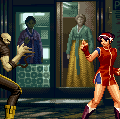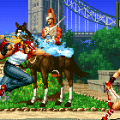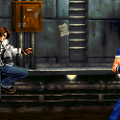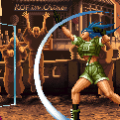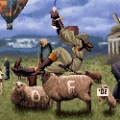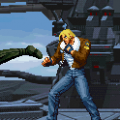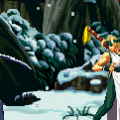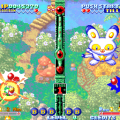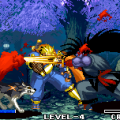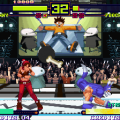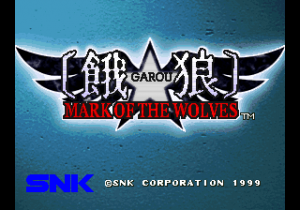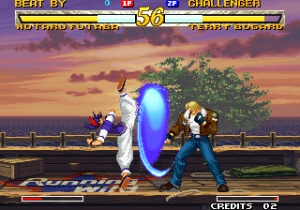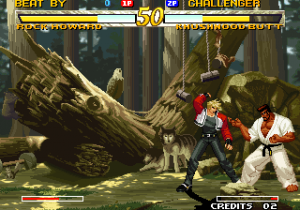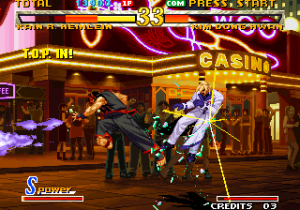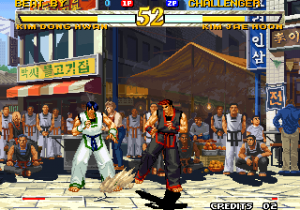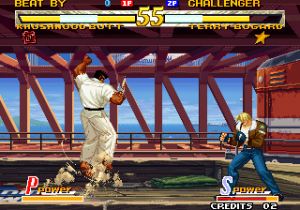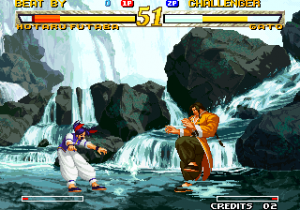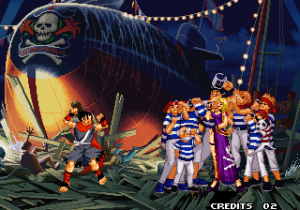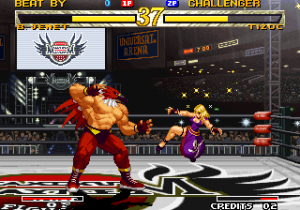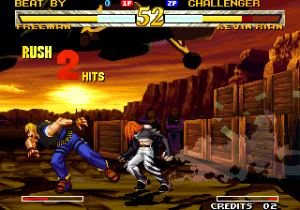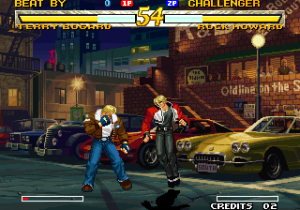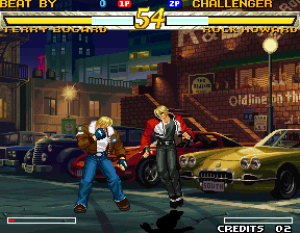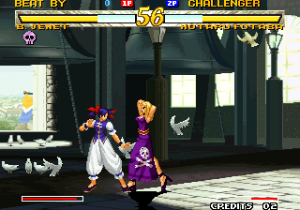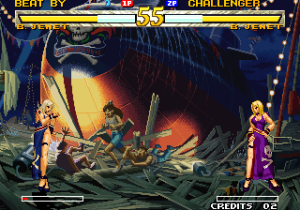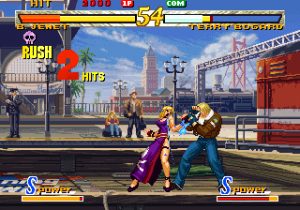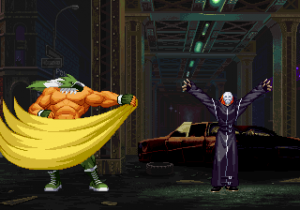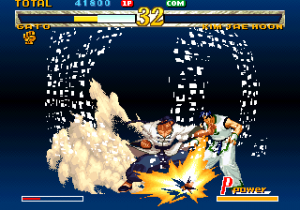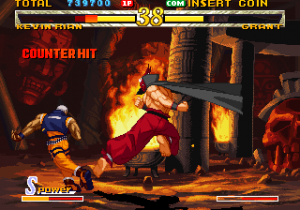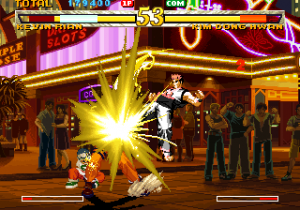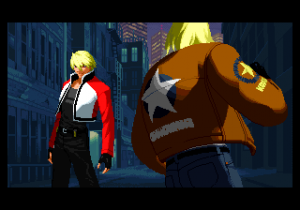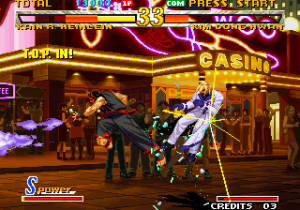Garou: Mark of the Wolves is often compared to Street Fighter III for a number of reasons. For starters, both have some of the most gorgeously smooth animation ever seen in a 2D fighting game. Both greatly overhauled the play mechanics and also introduces a completely new character roster, resulting in a game that feels significantly detached from its predecessors. And both represent the pinnacle of 2D fighting game design for both companies.
Garou: Mark of the Wolves takes place in the then near future of 2008. The intro recounts how Geese denied Terry’s aid and fell to his death from the top of his tower. Overwhelmed with guilt, Terry raises Geese’s son Rock, hoping to prevent him from following in his father’s footsteps. The plot begins when a man named Kain R. Heinlein, who has risen to power as crime boss of post-Geese Howard Southtown. Several years earlier, Geese had been romantically involved with Kain’s sister, Marie. Kain resented Geese and forced Marie out of his estate. He later found out that Marie and Geese had a child together, Rock Howard, and he organized the King of Fighters Maximum Mayhem tournament to draw both Rock and Terry to himself.
From the old cast, only Terry Bogard is back for this installment, so the rest of the fighters are completely original, albeit several of them are vaguely based on previously existing SNK characters. There are only twelve playable characters (fourteen in the home versions), an extremely small roster for its time, but it’s such a great game that this can easily be overlooked.
While the design is still very similar to prior Fatal Fury installments, the combo system and overall feel of the game more closely resembles The King of Fighters than anything else. It takes several elements from both series, improves most of them, and introduces a multitude of other features that work to give players as many, if not more, options than in any other 2D fighter. So yeah, it’s absurdly complex, but it’s still less intimidating in that respect than Virtua Fighter or Street Fighter III.
To begin with, the control scheme of the Real Bout games has been abandoned in favor of the standard four attack buttons – two for punches, and two for kicks – and plane switching is gone entirely. The back hop, short jump, and long jump are still in. Eight of the characters can dash, and the remaining six can all run. The quick recovery after a knockdown this time can be followed up by evading left or right, either over a short or a long distance. Desperation moves have been removed, and H. Power no longer applies, but S. Power Supers and P. Power Supers are still present. The super meter works more like in The King of Fighters, so they build up permanent stocks, rather than gradually depleting after maxing out like in the Real Bout games. P. Power Supers are the stronger versions of the moves and require both stocks to execute, while S. Power Supers are content with one. Lastly, characters can no longer normally air block.
But the system changes don’t end there: Pushing both the A and C buttons at once while holding the joystick in either the Forward or Down positions executes feint moves – versions of the regular specials that abruptly end after the first few frames. Feint Moves have quicker recovery, so they can lead to combos that aren’t possible otherwise. Throws can be escaped from by pushing the joystick either forward or back along with either the C or D buttons just after your opponent’s animation to throw you begins. Pushing both the A and B buttons at once will counter low attacks with an overhead attack. If this same command is combined with pushing the joystick down, it will perform a high attack that can be canceled into specials or supers. Each character has a breakable move (or moves) that can have its animation completely halted – allowing to recover quicker if it’s whiffed, or to set up other moves easier. Blocking too often might get punished by a guard crush. The danger of this is not actually displayed on screen, but the character begins to flash when really close.
Another reason Garou is compared to Street Fighter III is the presence of an advanced blocking technique. A Just Defend, as it is called here, is performed by executing a block during the exact same frame of animation that an opponent’s attack would hit. If this is performed successfully, the words “Just Defend” flash on screen and the defender regains a small bit of health. The amount of this is determined by the strength of the attack. Just Defending has quicker recovery time that blocking does, and does not contribute to guard crush. It’s also possible to guard cancel a Just Defend into a super, and to Just Defend while airborne. Just Defend even works multiple hits in a combo by releasing the joystick after each hit is blocked. This method of executing the move arguably makes Just Defending the closest to perfection of any form of advanced blocking. Street Fighter III requires to perform a Parry by pushing forward, which leaves absolutely no room for error whatsoever. Performing the technique by pushing back allows to still block normally if the timing is not correct. So it’s a much safer, and more accessible, technique and can be a more relevant part of gameplay.
Another complex element to Garou is its T.O.P. (Tactical Offensive Positioning) system. After selecting a character follows a prompt to highlight a portion of the life bar. When the character’s health is in that portion the T.O.P. system will take effect and grant access to multiple abilities. This includes a special T.O.P. attack with a shadowy visual effect, which can only be performed while in this mode. T.O.P. attacks are character specific, but are always performed by pushing C & D together. In the console versions, the size of the T.O.P. bar can also be adjusted – the smaller it is, the greater the buff, but in turn it of course it doesn’t last as long against damage. Attacks are stronger during this period and health is replenished very slowly.
SNK games almost always had amazing graphics, and Garou‘s rank up there with the best-looking sprite art games ever made. The graphical style is similar to that of The King of Fighters, and every background has a lot of things going on. The birds in the bell tower stage, and the Last Blade and KoF cameos in the traffic jam stage are especially nice details. Terry Bogard’s stage resembles his arena in Fatal Fury 2 and Special, with its moving train car setting, and is easily the best looking level in the game. It offers a much more extensive look at Southtown than any previous game provides. Stages are set all over – from docks, to alleyways, to casinos – and make Southtown seem like an expansive, lively, busy place. Pushing the Start button not only performs a taunt, but also causes something in the background to animate (this is most noticeable in the bell tower stage). Every character has two hidden win animations that can be viewed by holding the joystick to the left or right and pushing the Start button. The total number of animation frames is probably the highest for any sprite based fighter other than Street Fighter III. Each character animates so fluidly that the precise timing required for Just Defending is much easier.
Garou is arguably among the best fighters ever made, and without question among the most refined. It’s often said to be SNK’s best fighter, and it tends to have the most fans among those who normally do not like their offerings in the genre.
Three ports of Garou were released. The Dreamcast version is almost perfect, but has lagging sounding effects and some minor issues that are all but unnoticeable unless for those that have played the Neo Geo versions for hours on end. It was brought to America by Agetec under the title Fatal Fury: Mark of the Wolves, although the title screen still uses the original name. The PlayStation 2 version, released in Japan in 2006 as part of the Neo Geo Online Collection, fixes these issues and adds online play, but only in Japan. Both versions feature an arranged soundtrack created specifically for the home releases, but the quality of these songs are somewhat questionable compared to other SNK soundtracks. Instead of using live instruments like many of their other CDs, it seems like they ran the original Neo Geo soundtrack through a cheesy MIDI sequencer, which makes it sound pretty cheap. It’s definitely cleaner than the original music, but it’s also lost a lot of its edge. Both versions also allow both bosses to be played without a cheat code, and the Dreamcast version has an art gallery. The Xbox 360 version is only available on the Xbox Live Arcade. It’s basically the same as the PS2 port, meaning it plays perfectly, although it’s missing the arranged tracks. Naturally, it allows for online play, although the netcode quality is iffy.
Characters
Terry Bogard
Terry is the only returning Fatal Fury character in Mark of the Wolves. Since over a decade has passed, he’s now a bit older, and has ditched his old red ensemble for a leather jacket and a new hairdo. Otherwise, he’s pretty much about the same as he is remembered from the previous games. Terry appears wearing this outfit in The King of Fighters 2003 and XI, before the HD sequels turn him back into his classic variant. It is also unlockable as an alternate character in Maximum Impact 2.
Rock Howard
Rock Howard is first introduced in Terry’s ending for Fatal Fury 3. His father was Geese Howard and his mother was a woman named Marie Heinlein. After Marie passes away and Geese kills himself at the end of Real Bout, Rock is raised by Terry, who is overwhelmed with guilt about the death of his father. With Terry as his mentor, Rock becomes a very skilled fighter. His moveset is a combination of Terry’s and Geese’s. His head is almost identical to that of Kaede from Last Blade. Rock has never appeared in the main KoF series, but is included in Maximum Impact 2.
Kim Dong Hwan
Kim Kaphwan has apparently disappeared during the time of Mark of Wolves, and so both of his sons begin to search for him. Kim Dong Hwan shares a similar look and fighting style with his father, although many of his specials have lightning power. Despite his father’s strict discipline, he is a goof-off and is much lazier than his brother. His name is actually borrowed from a younger brother of the real life Kim Kap Hwan
Kim Jae Hoon
Kim Jae Hoon is the more skilled, disciplined, serious, and reserved of the two Kim brothers, which makes him much more like his father. He shares his father’s sense of justice and most of his move set (with added fire bonus), and even has the same intro animation against opponents that he believes to be evil. He is constantly scolding Dong Hwan for being lazy and arrogant, but the two must get along pretty well because Dong Hwan can be seen in Jae Hoon’s level background. He bears the name of the actual son of the real Kim Kap Hwan.
Hotaru Futaba
Hotaru Futaba is an easy-going young martial artist who moves very gracefully. She has no interest in fighting and only does so because she is looking for her disappeared brother Gato. Her first name means firefly in Japanese, which explains a few of her animations. She has a pet ferret named Itokatsu that shows up in her intro and win animations.
Marco Rodriguez / Khushnood Butt
Marco Rodriguez hails from Brazil, and was taught Kyokugenryu Karate by Ryo Sakazaki. As would be expected, his move set is very similair to that of Ryo, Robert Garcia, and Mr. Karate. Someone decided to rename him Khushnood Butt for the English release of Mark of the Wolves.
Hokutomaru
Hokutomaru is a young ninja who is being trained by Andy Bogard. He enters the KoF Maximum Mayhem tournament after Andy suggests he does so to test his skills. He is highly energetic and something of a goof-off. He shares a move with Andy, but is otherwise pretty different from any other SNK fighters. He has a cameo in Mai’s ending in SVC Chaos.
Kevin Rian
Kevin Rian is a S.W.A.T. team member whose partner was killed by Freeman. He is looking for Freeman to arrest him, and travels with a kid named Marky. That his characterization is limited to the cliched “cop out to get revenge” theme sort of makes him SNK’s equivalent of Kevin Striker from Mortal Kombat.
Griffon Mask / Tizoc
Griffon Mask is a former priest and current wrestler who is based on Fray Tormenta, a real world luchadore with the same background. By the time the events of Mark of the Wolves occur, his wrestling career has pretty much ended. At the request of Terry Bogard, he decides to enter the tournament to motivate himself to get back in the ring. A few of his moves suggest that he is also partially based on the Japanese pro wrestler Tiger Mask.
Gato
Gato is a martial arts master who is introduced in Mark of the Wolves and later appears in The King of Fighters 2003. He has no memory of his past, but does not seemed even slightly concerned about this. Instead he wanders Southtown looking for challengers to fight. There are three parallel scars across his back, bearing witness to a troubled past.
Bonne Jenet
B. Jenet is the leader of a group of pirates called The Liline Knights. Her portrayal is overtly feminine and her demeanor is excessively flirtatious. She isn’t strictly a fan-service character, but often rather played for light humor. Being a pirate, when she heard that the very wealthy Kain R. Heinlein was holding a King of Fighters tournament, she joined the tournament looking for treasure. First introduced in Mark of the Wolves, B. Jenet later appears in The King of Fighters XI and Maximum Impact 2.
Freeman
Freeman is a serial killer vaguely reminiscent of The King of Fighters‘ Iori Yagami. This time’s KoF tournament must not be very public, since a serial killer enters the tournament without hesitation. The police do eventually find out, and after being shot by a sniper, he simply disappears. Like Vice and Mature from KoF, most of his moves are named after Heavy Metal groups. During his intro animation, he wears a costume that could be a homage to Halloween villain Michael Myers.
Grant
Grant is a huge guy in a mask and the default boss of Garou. He is a long time companion of Kain R. Heinlein. Grant followed him and became his enforcer during his rise to power as the crime boss of post-Geese Southtown. Other mobsters attempted to have Grant killed and shot him in the chest. He survived, but the bullet was too close to his heart to be removed. So it remains there to this day, threatening to end his life. He is playable via a cheat in the arcade version of Garou, and freely selectable in the console ports. His real name is Abel Cameron.
Kain R. Heinlein
Kain R. Heinlein is named after novelist Robert A. Heinlein. He is the current crime boss of Southtown. When he and Grant were younger, they witnessed a boy being attacked and did nothing to intervene, hoping that the attackers would relent. After the boy was beat to death, they buried the child at the beach and Kain became determined to gain power and influence so that he may avoid falling victim to other’s violence. He is the true final boss of the game, who can only be reached by meeting specific conditions.
